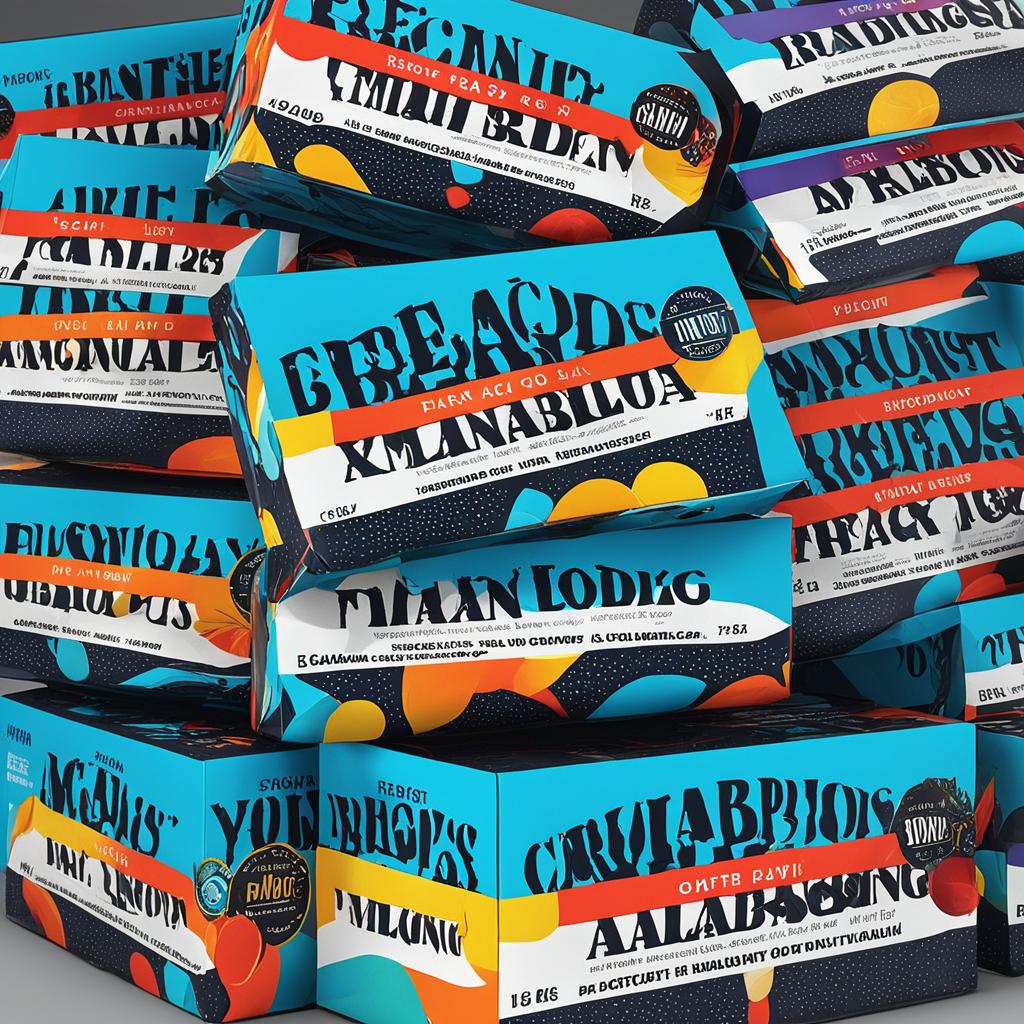Selling food online is a rewarding opportunity in today’s digital age. With the food and grocery market set to reach a value of 4.2 trillion US dollars by 2027, there has never been a better time to tap into this thriving industry.
However, successfully selling food online comes with its own set of challenges. From navigating packaging regulations to ensuring food safety, there are several factors to consider to ensure your online food business thrives.
In this comprehensive guide, I will provide you with a step-by-step blueprint to sell food online effectively. We’ll explore essential strategies and proven tips to help you establish a successful online food business.
Key Takeaways:
- Understand and comply with food regulations and safety guidelines.
- Choose a food niche that aligns with your passion and market trends.
- Find reliable suppliers with transparent supply chains.
- Create compelling packaging, branding, and labeling that resonate with your target audience.
- Pricing your food products strategically to maximize profitability.
Step 1: Know the Law
Before starting an online food business, it is crucial to understand and comply with the regulations. Familiarize yourself with the Cottage Food Laws, obtain the necessary licenses and permits, and ensure proper food storage and handling practices. Stay updated with food management and selling guidelines in your region and consider taking food safety courses to provide customers with peace of mind.
When it comes to selling food online, compliance with Cottage Food Laws is essential. These laws vary by state and typically govern the production and sale of certain food items from home kitchens. Understanding these laws will ensure that you operate within the legal framework and avoid any potential penalties or legal issues. It is important to note that these laws often have specific requirements regarding labeling, ingredient disclosures, and where and how food is prepared.
In addition to understanding Cottage Food Laws, it is crucial to prioritize food safety. Proper food storage and handling are critical to maintaining the quality and safety of your products. Ensuring that you and your staff undergo food handling training can help prevent foodborne illnesses and build trust with your customers. By following the proper procedures for storing, preparing, and serving food, you can minimize the risk of contamination and ensure that your products meet the highest standards of safety.
Taking food safety courses is a valuable investment in your business. These courses provide comprehensive training on best practices for handling, storing, and preparing food. They cover topics such as proper temperatures for storage and cooking, preventing cross-contamination, and maintaining a clean and sanitary food preparation area. By completing these courses, you can demonstrate your commitment to food safety and earn the trust of your customers.
By knowing and adhering to the regulations, practicing proper food storage and handling, and investing in food safety courses, you can operate your online food business with confidence. Not only will you be compliant with the law, but you will also provide your customers with the assurance that their health and safety are your top priorities.
Step 2: Choose Your Niche
Finding your niche in the food industry is crucial for standing out among competitors. By focusing on a specific food niche, you can tap into a targeted market and cater to the unique needs and preferences of your customers. Here are some steps to help you choose your niche:
- Consider your passion: Think about the types of food you are genuinely passionate about. Your love and enthusiasm for a particular cuisine or category can be the foundation of your niche.
- Conduct market research: Explore the current food trends and identify market gaps. Look for emerging food ideas that have the potential to become popular. Utilize online resources, such as food blogs, industry publications, and social media, to gather relevant information.
- Explore trending food ideas: Stay up-to-date with the latest food trends and innovations. This can include anything from plant-based and gluten-free options to unique fusion cuisines. Look for trending food ideas that align with your interests and have the potential for long-term success.
- Consider specialty food products: Explore the world of specialty food products that cater to specific dietary restrictions or preferences. This can include organic, vegan, keto-friendly, or allergen-free options. Specialty food products often garner a dedicated customer base looking for high-quality and unique offerings.
“Having a niche allows you to focus your efforts and resources on a specific target market, which can lead to stronger customer loyalty and higher profitability.”
Example: Trending Food Ideas
Here are some examples of trending food ideas that you can consider:
| Trending Food Ideas | Description |
|---|---|
| Fusion Cuisine | Combining elements of different culinary traditions to create innovative and exciting flavor profiles. |
| Plant-Based Options | Offering delicious and nutritious plant-based alternatives to traditional meat and dairy products. |
| Artisanal Coffee and Tea | Providing unique blends and brewing techniques for coffee and tea enthusiasts. |
| Superfoods and Functional Foods | Offering nutrient-rich foods that provide specific health benefits, such as antioxidant-packed berries or probiotic-rich fermented products. |
Remember, when choosing your niche, start with food ideas that align with your interests and don’t require significant investments. As your business grows, you can diversify and expand your product offerings based on customer feedback and market demand.
Step 3: Find Your Supplier
Whether you produce food products from scratch or curate items, finding a reliable supplier is crucial for the success of your online food business. Partnering with a trustworthy supplier ensures that you receive quality ingredients and products to offer your customers. When searching for a supplier, consider the following:
- Transparent Supply Chain: Look for suppliers who have a transparent supply chain, providing visibility into how the products are sourced and manufactured. This transparency helps ensure the integrity and safety of the products you sell. It also allows you to communicate the origin and quality of your ingredients to your customers, building trust.
- Shelf-Life: Assess the shelf-life of the products provided by potential suppliers. It’s important to offer food items with a decent shelf-life to avoid spoilage and minimize waste. Freshness and longevity contribute significantly to customer satisfaction and repeat purchases.
- Inventory Management: Optimize your inventory management practices to maintain food freshness and quality. Implement strategies like the first-in-first-out (FIFO) method to ensure that older products are sold first, minimizing the risk of expiration. Efficient inventory management helps prevent stockouts and aids in meeting customer demands promptly.
| Benefits of Finding a Reliable Supplier |
|---|
|
By selecting a supplier with a transparent supply chain, prioritizing shelf-life, and implementing effective inventory management, you can ensure that your online food business operates smoothly and satisfies customer expectations.
Step 4: Work on Packaging, Branding, and Labeling
Packaging, branding, and labeling are crucial aspects of your online food business that directly impact your brand image and customer perception. To ensure success and compliance, I recommend following these key steps:
Develop a Strong Brand Image
Creating a brand image that resonates with your target audience is essential in today’s competitive market. Your brand should reflect your values, personality, and the unique experience you offer. Consider the following when developing your brand image:
- Identify your target audience and understand their preferences and values
- Design a captivating and memorable logo that represents your brand
- Create a consistent and appealing visual identity across all digital channels
- Communicate your brand story and values through captivating content
Remember, a strong brand image can differentiate you from competitors and build trust with your customers.
Ensure Packaging Compliance with FDA Guidelines
Complying with packaging regulations is crucial to avoid legal issues and maintain customer safety. The FDA (Food and Drug Administration) provides guidelines to ensure packaging compliance. Keep the following in mind:
- Use food-grade materials that are safe for storing and transporting food products
- Consider environmental sustainability by using recyclable or biodegradable packaging
- Include proper labeling and warnings to inform customers of allergens or potential risks
Prioritize packaging that not only meets regulatory requirements but also protects the quality and integrity of your food products.
Provide Ingredient Transparency
Transparency is vital in building trust with your customers. It’s essential to clearly communicate the ingredients used in your food products. Here are some best practices for ingredient transparency:
- Clearly list all ingredients on your packaging in an easy-to-read format
- Highlight any allergens or common dietary restrictions to ensure customer safety
- Include information about the sourcing of your ingredients, such as organic or locally sourced
Transparency not only helps customers make informed choices but also establishes your credibility as a responsible food business.
Adhere to Labeling Rules
Labeling rules may vary based on region, so it’s crucial to understand and follow the specific regulations in your area. Consider the following when creating labels for your food products:
- Include mandatory information such as product name, net weight, and expiration date
- Comply with nutritional labeling requirements, including calorie counts and nutrient information
- Ensure all labels are accurate, clear, and prominently displayed on your packaging
By adhering to labeling rules, you demonstrate professionalism and provide customers with the necessary information to make informed choices.
Remember, packaging, branding, and labeling are integral components of your online food business. They not only enhance your brand image but also ensure compliance and customer satisfaction. Invest time and resources in developing packaging that stands out, branding that resonates, and labels that provide transparency.

| Benefits of Effective Packaging, Branding, and Labeling | Examples |
|---|---|
| Enhanced brand recognition and loyalty | An eye-catching logo and consistent visual identity across platforms |
| Increased customer trust and confidence | Transparent ingredient lists and compliance with labeling rules |
| Improved product visibility and differentiation | Unique packaging design that stands out on shelves and online |
| Clear communication of product information | Easy-to-read labels with accurate nutritional and allergen information |
Step 5: Price Your Food Products
Pricing your food products is a crucial step in determining the value they offer to customers. It requires careful consideration to strike a balance between competitive pricing, profit margins, and the perceived value of your offerings. By conducting industry research and understanding your target market’s expectations, you can develop effective pricing strategies that drive sales and contribute to your business’s success.
“The price of your food products should reflect the quality and uniqueness they bring to the market.”
When setting your prices, it’s important to gather industry research and analyze the pricing trends of similar products. This will help you gauge the competitive landscape and position your prices accordingly. Consider factors such as production costs, packaging expenses, and any additional value-added services you provide.
While it may be tempting to charge lower prices to attract more customers, it’s essential to understand the impact on your profit margins. Selling products at extremely low prices could compromise your profitability and long-term sustainability. Instead, find a balance that ensures fair compensation for your efforts without alienating potential customers.
On the other hand, pricing your food products too high may create a perception of overpricing, leading to customer resistance. It’s crucial to strike a chord between value and affordability. To achieve this, assess the unique selling points of your products, such as premium ingredients, artisanal craftsmanship, or ethical sourcing practices, and price them accordingly.
Remember, perceived value plays a vital role in influencing customers’ purchasing decisions. Emphasize the quality, taste, nutritional benefits, and other unique attributes of your food products in your marketing efforts. Highlighting these factors can justify a higher price point and differentiate your offerings from competitors.
Key Pricing Strategies
Here are some pricing strategies to consider when determining the best approach for your food products:
- Cost-plus pricing: Calculate the production costs and add a desired profit margin to determine the selling price.
- Competitive pricing: Set your prices in line with or slightly lower than the prices of similar products in the market.
- Value-based pricing: Price your products based on the perceived value they offer to customers, considering their quality, uniqueness, and benefits.
- Bundling: Combine related food products or offer meal packages to increase the perceived value and encourage higher spending.
- Promotional pricing: Temporarily reduce prices or offer discounts to attract customers during specific periods or events.
Ultimately, finding the right pricing strategy for your food products requires a thorough understanding of your target market, industry dynamics, and the value your offerings bring to the table. Continuously monitor market trends, customer feedback, and make adjustments as needed to optimize your pricing strategy.
| Pricing Strategies | Advantages | Disadvantages |
|---|---|---|
| Cost-plus pricing | Ensures profitability, covers production costs | May not consider market demand or competition |
| Competitive pricing | Allows for price positioning in the market | Can lead to price wars or lower profit margins |
| Value-based pricing | Reflects the unique value of your food products | Requires effective communication of value to customers |
| Bundling | Increases customer spending and perceived value | Must carefully manage inventory and pricing structure |
| Promotional pricing | Attracts customers during specific periods or events | May affect profit margins if applied too frequently |
Step 6: Create Your Online Store
Setting up an online store is an important step towards establishing your online presence and reaching a wider audience. A well-designed website is essential in creating a positive user experience and showcasing your food products effectively. Here are some key considerations for creating your online store:
Choose a Reputable Store Builder
When designing your website, it’s crucial to choose a reputable store builder that offers user-friendly features and customizable templates. One popular option is Shopify, a trusted platform that allows you to create a visually appealing website without extensive coding knowledge.
With a user-friendly interface and a wide range of templates to choose from, Shopify makes it easy to design a website that reflects your brand image and values.
Create Visually Appealing Product Photography
High-quality product photography plays a vital role in capturing the attention of potential customers. Invest in professional product photography that showcases the unique features and qualities of your food products. Clear, well-lit images that highlight the freshness, texture, and presentation of your dishes will entice customers to make a purchase.
Remember to optimize your images for web use to ensure fast loading times and seamless browsing experience for your visitors.

Write Persuasive Product Descriptions
In addition to visually appealing product photography, persuasive product descriptions are crucial for convincing customers to make a purchase. Craft compelling descriptions that highlight the unique qualities, flavors, and benefits of your food products. Use descriptive language to create a sensory experience for the customers and ignite their cravings.
Make sure to mention any specific ingredients, cooking techniques, or dietary considerations to cater to a wide range of preferences and dietary requirements.
Maintain Branding Consistency
Consistency in branding is key to building recognition and trust among your customers. Ensure that your website design, typography, color palette, and logo align with your brand identity across all digital channels.
By maintaining consistent branding, you create a cohesive and memorable experience for your customers, reinforcing your brand image and establishing trust.
“A visually appealing website design, high-quality product photography, persuasive product descriptions, and consistent branding are vital elements in creating an enticing and trustworthy online store for your food business.”
Step 7: Promote Your Food Business
Promoting your online food business is essential for attracting customers and increasing your market presence. By utilizing various marketing strategies, you can effectively showcase your food products and connect with your target audience.
Utilize Social Media Marketing
Social media platforms like Instagram and Facebook offer excellent opportunities to engage with potential customers and showcase your food products. Create visually appealing posts and stories that highlight the unique aspects and mouthwatering appeal of your offerings. Share captivating images, videos, and behind-the-scenes content to captivate and entice your audience.
Form Influencer Partnerships
Collaborating with food influencers can significantly expand your reach and expose your brand to a wider audience. Find influencers who align with your brand values and target market. Partnering with influencers can create buzz, generate excitement, and inspire trust among their loyal followers.
Implement Content Marketing Strategies
Content marketing allows you to share valuable and relevant content that builds your authority and establishes your brand as a trusted source. Consider sharing recipes, cooking tips, and nutritional information on platforms like Pinterest. This not only increases your online visibility but also positions you as an expert in the food industry.
Offer Customer Incentives
To encourage customer loyalty and repeat purchases, consider offering incentives such as discounts, loyalty programs, or freebies. Create a personalized experience for your customers by providing special offers for their birthdays or anniversaries. These incentives can incentivize customers to choose your online food business over competitors.
Collaborate with Larger Brands or Supermarkets
Partnering with larger brands or supermarkets can provide a significant boost to your brand’s visibility and credibility. Explore opportunities to collaborate on joint marketing campaigns or showcase your products in their physical or online stores. This can not only expand your market presence but also attract new customers.
| Strategy | Advantages |
|---|---|
| Social Media Marketing |
|
| Influencer Partnerships |
|
| Content Marketing |
|
| Customer Incentives |
|
| Collaboration with Larger Brands or Supermarkets |
|
Research Food Laws
Understanding food laws and regulations is essential for selling food online. As a responsible online food business owner, it is crucial to comply with these regulations to ensure public safety and avoid any legal consequences. Government organizations rigorously regulate and monitor the food industry to maintain high standards of food safety and quality. Failure to comply with food laws, such as packaging regulations or proper food handling practices, can result in serious legal ramifications, including fines or even closure of the business.
Proper food handling is a top priority when navigating the online food space. This includes practices such as safe storage, hygiene protocols, and thorough cleaning procedures to minimize the risk of contamination. By adhering to food safety guidelines and implementing appropriate measures, you can ensure that your customers receive safe and high-quality food products.

Supply chain tracing is another important aspect of food laws and regulations. As an online food business owner, it is crucial to have transparency in your supply chain to ensure the integrity and safety of your products. Tracing the origin and journey of your ingredients helps identify potential risks and allows for timely recalls if necessary.
Insurance coverage is also essential when selling food online. It protects your business from unforeseen circumstances or liability in case of foodborne illnesses or other incidents related to your products. By having appropriate insurance coverage, you can safeguard your business financially and provide peace of mind to your customers.
Key Points:
- Complying with food laws and regulations is crucial for online food businesses.
- Non-compliance can result in legal consequences, such as fines or closure.
- Proper food handling practices are essential for ensuring public safety.
- Supply chain tracing helps maintain the integrity and safety of food products.
- Insurance coverage protects the business from unexpected incidents.
Find Your Niche
Finding your food niche is a crucial step towards building a successful online food business. It involves identifying a specific target market or unique offering that sets you apart from the competition. Here’s how you can discover your niche:
- Tap into your passion: Consider your personal interests and culinary passions. What type of food excites you the most? Choose a niche that aligns with your passion and expertise to make your business truly enjoyable.
- Stay updated with market trends: Research current market trends and consumer preferences. Stay ahead of the game by identifying emerging food niches that have great potential for growth.
- Problem-solving: Look for gaps in the market and identify problems that food enthusiasts face. Develop a niche that addresses these issues and offers unique solutions.
- Unique offering: Differentiate yourself by providing a unique offering that stands out from the competition. It could be a specific cuisine, organic and sustainable ingredients, or catering to specific dietary needs like gluten-free or vegan options.
By researching market trends, understanding consumer needs, and leveraging your passion, you can find a niche that allows you to create a truly distinctive online food business.
Check out the table below for some popular food niche examples:
| Niche | Description |
|---|---|
| Craft Chocolate | Artisanal and handcrafted chocolate products made with high-quality ingredients. |
| Farm-to-Table | Emphasizes using fresh, locally sourced ingredients to create flavorful and sustainable dishes. |
| Plant-Based Cuisine | Offers a variety of plant-based dishes for vegans and health-conscious individuals. |
| Specialty Coffee | Focuses on specialty and single-origin coffee beans, delivering a unique coffee experience to customers. |
Explore different food niche opportunities and choose the one that aligns with your passion and market demand. A well-defined niche will help you attract dedicated customers who appreciate your unique offerings.
Decide on a Business Model: Produced vs. Curated
When starting an online food business, the first decision you need to make is the type of business model you want to pursue. You can either choose to produce your own food products or curate products from other brands. Both options have their advantages and considerations depending on your resources, goals, and target market.
Self-Production: Control and Flexibility
If you opt for self-production, you take on the responsibility of creating your own food products. This allows you to have full control over the production process, ensuring that your products meet your desired quality standards and align with your brand vision. It also gives you the flexibility to experiment with different recipes, ingredients, and flavors, allowing for innovation and customization.
However, self-production requires more investment in terms of time, effort, and resources. You’ll need to establish your own production facilities, source high-quality ingredients, and adhere to food safety regulations. Additionally, scaling up can be challenging, as you may need to invest in larger production capacities, distribution channels, and workforce as your business grows.
Third-Party Manufacturing: Scalability and Efficiency
On the other hand, if scalability and efficiency are your primary considerations, you may opt for third-party manufacturing. This involves partnering with existing food manufacturers or processors who specialize in producing food products on behalf of other brands. By leveraging their expertise and production capabilities, you can focus on sales, marketing, and building your brand.
By choosing third-party manufacturing, you can access established supply chains, economies of scale, and streamlined production processes. This enables you to quickly scale up your operations without significant investments in infrastructure and equipment. It also allows you to offer a wider range of products by collaborating with different manufacturers for various categories.
Brand Curation: Focus on Sales and Marketing
Another alternative is brand curation, where you curate food products from other brands to build your online store’s assortment. This approach allows you to tap into the expertise and popularity of established food brands without the need for self-production or third-party manufacturing. You can select products that best align with your brand identity and target market.
By focusing on sales and marketing, you can dedicate your efforts to building a strong brand image, enhancing customer experience, and implementing effective marketing strategies. Brand curation requires excellent sourcing and curation skills to ensure that the products you select meet the quality standards and expectations of your customers.
Decision Factors: Resources, Goals, and Target Market
When deciding on the best business model for your online food business, consider your available resources, business goals, and target market. Assess the feasibility and scalability of each option and evaluate the level of control, investment, and expertise required. You may also need to conduct market research to understand customer preferences and trends within your niche.
To help you visualize the differences between the self-production, third-party manufacturing, and brand curation models in terms of key factors, here’s a table summarizing the considerations:
| Self-Production | Third-Party Manufacturing | Brand Curation | |
|---|---|---|---|
| Control | High | Medium | Low |
| Scalability | Challenging | High | Medium |
| Investment | High | Medium | Low |
| Expertise Required | High | Low | Medium |
Table: Comparison of Business Model Considerations
Use this table as a tool to guide your decision-making process. Evaluate which business model aligns best with your goals, available resources, and the unique needs of your target market.

Source Ingredients
Sourcing high-quality ingredients is crucial for creating delicious food products. When it comes to finding the best ingredients, you have several options to consider based on your budget and specific requirements. Here are some sources to explore:
Grocery Stores
Grocery stores are a convenient option for sourcing ingredients, offering a wide range of fresh produce, pantry staples, and specialty items. They often provide a variety of brands and options to choose from, allowing you to select the best ingredients for your recipes. When shopping at grocery stores, pay attention to the quality, freshness, and origin of the ingredients to ensure optimal taste and flavor.
Local Suppliers
Supporting local suppliers not only contributes to the community but also ensures a closer connection to the source of your ingredients. Local farmers, butchers, and artisans often offer high-quality products with a focus on freshness and sustainability. Building relationships with these suppliers can provide you with access to unique and seasonal ingredients that can elevate your food products.
Warehouses
Warehouses are another option for sourcing ingredients, particularly if you require bulk quantities or specialized ingredients for large-scale production. These facilities often have a wide range of products available at competitive prices. However, make sure to assess the quality and freshness of the ingredients before making bulk purchases to maintain the excellence of your final products.
Quality Assessment
Regardless of the source, it is essential to conduct a thorough quality assessment of the ingredients you procure. Check for attributes such as freshness, color, texture, and aroma to ensure that you are using the best ingredients for your recipes. Additionally, consider the sustainability and ethical practices of the suppliers to align with your values and meet the expectations of eco-conscious consumers.
Incorporating high-quality ingredients sourced from reputable establishments adds value to your food products, setting them apart in taste and overall experience. Remember that the quality of your ingredients directly impacts the final outcome, so invest time and effort in sourcing the best ingredients available.
Conclusion
Starting an online food business is an exciting venture that holds great potential for success. By carefully following the necessary steps and implementing effective strategies, you can establish a thriving presence in the competitive online market.
One of the key aspects of building a successful online food business is adhering to food laws and regulations. Ensuring compliance not only protects your customers but also safeguards your business from legal consequences. Stay informed about food safety practices, obtain the required licenses and permits, and prioritize proper food handling and storage.
Finding your niche is another critical factor in online food business success. Identify your passion or conduct market research to uncover trending food ideas. By specializing in a specific food niche, you can differentiate yourself from competitors and cater to a targeted audience. Consider unique offerings or dietary restrictions, and align your products with market trends to captivate your customers.
Additionally, sourcing reliable suppliers is vital for maintaining the quality and consistency of your food products. Choose suppliers with transparent supply chains and assess the shelf-life of the ingredients you use. Good inventory management practices, like the first-in-first-out strategy, will help guarantee the freshness and customer satisfaction.
Implementing effective marketing strategies is essential for promoting your online food business. Utilize social media platforms, collaborate with food influencers, and engage in content marketing to expand your reach and attract customers. Remember to focus on branding consistency, offer customer incentives, and explore partnership opportunities to increase your market presence.
By following these tips and strategies, prioritizing food safety, delivering consistent branding, and ensuring customer satisfaction, you can position your online food business for success. Establish a strong foundation, adapt to market trends, and continuously innovate to stay relevant in the ever-evolving world of online food sales.
FAQ
How can I sell food online?
To sell food online, you need to start by understanding the laws and regulations surrounding food sales. Familiarize yourself with Cottage Food Laws, obtain the necessary licenses and permits, and ensure proper food storage and handling practices.
How do I choose a niche for my online food business?
When choosing a niche for your online food business, consider your passion for specific food types or conduct market research to identify trending food ideas. You can also focus on catering to specific dietary restrictions or offering gourmet and artisanal products.
How do I find a reliable supplier for my food products?
Finding a reliable supplier is crucial for your online food business. Choose suppliers with transparent supply chains and ensure the products have a decent shelf-life. Proper inventory management, such as using the first-in-first-out strategy, is also important.
How important is packaging, branding, and labeling for my online food business?
Packaging, branding, and labeling play a significant role in the success of your online food business. Develop a brand image that resonates with your target audience and ensure packaging complies with FDA guidelines. Provide ingredient transparency and adhere to labeling rules specific to your region.
How should I price my food products?
Pricing your food products requires careful consideration. Conduct industry research to determine competitive prices and set your prices based on the value your food products offer. Avoid charging too little, as it may affect profit margins, and be cautious of pricing too high, as it may deter potential customers.
How can I create an online store for my food business?
Setting up an online store is essential to establish your online presence. Use a reputable store builder like Shopify to design an attractive website that reflects your brand. High-quality product photography and persuasive product descriptions are crucial for enticing customers. Maintain brand consistency across all digital channels to enhance recognition and trust.
What are some effective ways to promote my online food business?
Promoting your online food business is crucial for attracting customers. Utilize social media platforms like Instagram and Facebook to showcase your food products through engaging posts and stories. Consider forming partnerships with food influencers or guest blogging to expand your reach. Additionally, utilize content marketing strategies like sharing recipes on platforms such as Pinterest.
What should I know about food laws and regulations?
Understanding food laws and regulations is essential for selling food online. Government organizations regulate and monitor the food industry to ensure public safety. Complying with the rules is crucial, as non-compliance can result in legal consequences such as fines or closure of the business.
How do I find the right niche for my online food business?
Finding your food niche involves identifying a specific target market or unique offering. It can be based on personal interests, trends, or filling a gap in the market. Choosing a niche allows you to cater to specific dietary needs or preferences, such as organic, gluten-free, or specialty cuisines.
Should I produce my food products or curate them from other brands?
When starting an online food business, you must decide on a business model. You can choose to produce your food products or curate products from other brands. Self-production offers control and flexibility, while third-party manufacturing allows for scalability. Curating products allows you to focus on sales and marketing.
Where can I source high-quality ingredients for my online food business?
Sourcing high-quality ingredients is crucial for creating delicious food products. Consider options such as grocery stores, local suppliers, or warehouses, depending on your budget and specific ingredient requirements. Thoroughly assess the quality and freshness of ingredients to ensure the excellence of your final products.
Our Friends
- https://www.oberlo.com/blog/how-to-sell-food-online
- https://www.upmenu.com/blog/how-to-sell-food-online/
- https://www.shopify.com/blog/213396233-how-to-start-a-food-business
Money posts:
 How to Make Money on Amazon
How to Make Money on Amazon
 How to Make Money on Etsy in [Year]: A Complete Guide for Success
How to Make Money on Etsy in [Year]: A Complete Guide for Success
 Best Cacao Confectioneries: Where to Find the Finest Chocolate Sweets (2024)
Best Cacao Confectioneries: Where to Find the Finest Chocolate Sweets (2024)
 Best Cacao-Based Snacks: Healthy and Tasty Chocolate Treats (2024)
Best Cacao-Based Snacks: Healthy and Tasty Chocolate Treats (2024)
 7 Tips to Starting a Business with No Money (2024)
7 Tips to Starting a Business with No Money (2024)
 23 Ways to Make Money with a Laptop in 2024
23 Ways to Make Money with a Laptop in 2024
 Are You An Entrepreneur? | Here Are My 7 Tips for ALL (2024)
Are You An Entrepreneur? | Here Are My 7 Tips for ALL (2024)
 How To Flip A Niche Website For $40k Profit in 2024
How To Flip A Niche Website For $40k Profit in 2024

